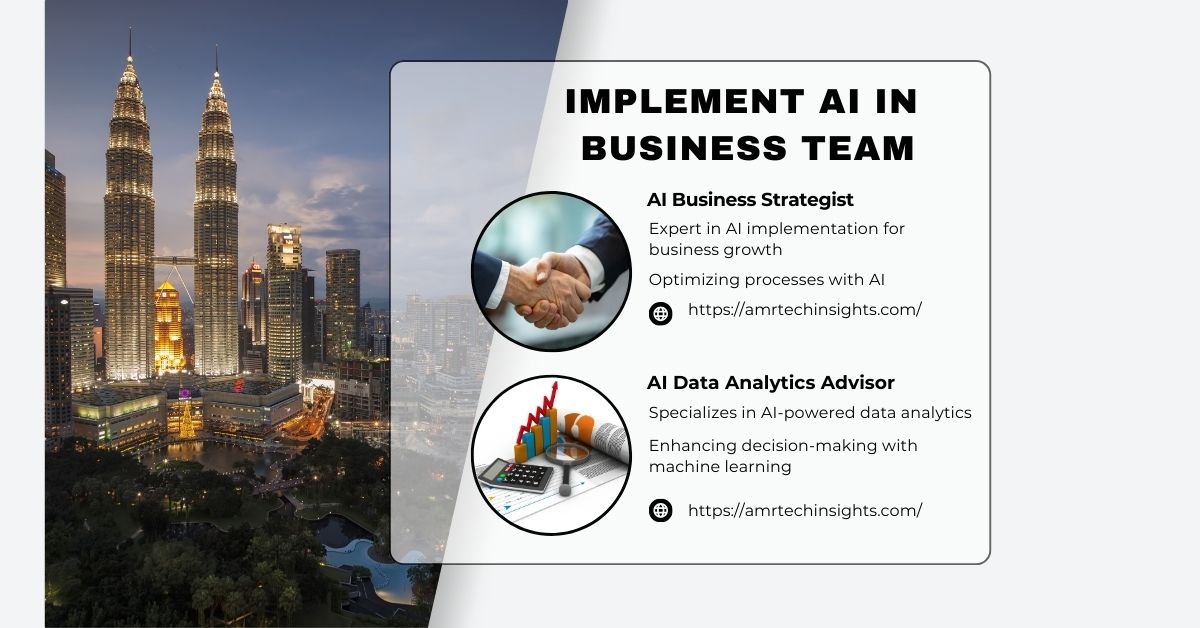AI isn’t just something that will happen in the future; it’s a competitive edge right now. Companies that implement AI in business are using it at an unprecedented rate to improve customer service and anticipate sales trends. PwC says that AI might add $15.7 trillion to the world economy by 2030 [PwC Report]
That means that businesses that use AI early potentially have a big advantage. But for a lot of CEOs, the key issue is still: How do I really start using AI in my business?
This tutorial is meant for people who are just starting off and want to implement AI in business. I’ll make the process apparent by giving you step-by-step directions, explaining important concepts in simple language, and providing real-world data and case studies. By the conclusion, you’ll be sure of how to start your AI adventure.
Step 1: Learn what AI can and can’t do.
You need to know exactly what AI does before you start. AI is like a strong helper that helps you look at data, do jobs automatically, and get new ideas. But it’s not magic; it works best when used on situations that are clear and well-defined.
- Tip for beginners: Consider AI to be a calculator. It won’t draft your business plan, but it can do math faster than you ever could.
- According to McKinsey, organizations that use AI in at least one area have an average cost savings of 20% [McKinsey AI Report]
- A common mistake is thinking that AI will “replace humans.” Instead, it should help people make decisions.
Step 2: Where to Implement AI in Business.

AI is changing customer service by making chatbots available 24/7 and allowing for individualized interactions that make customers happier and save expenses. Many of these strategies are also covered in our AI for Businesses: Strategies, Tools, and Case Studies to Transform Operations, where real-world use cases show how companies achieve both efficiency and scalability. Businesses that use AI become more responsive and better at predicting sales. This picture shows how AI technologies may help teams work better and get more customers in real-world business situations.
AI isn’t necessary for every job. Figure out where AI may help you save time, save money, or make better decisions. For example, entrepreneurs exploring how to start an AI marketing agency often begin by using chatbots, predictive analytics, and personalized campaign tools to deliver faster results for clients.
For example:
- Customer service: AI chatbots that are available 24/7.
- Sales forecasting is using machine learning algorithms to guess how much demand there will be.
- Operations → Making back-office procedures that need to be done again and again automatic.
- Tip for beginners: Find the “pain points” in your organization that make staff unhappy or hinder growth.
- According to Gartner, 70% of businesses that use AI do so to improve customer service and sales initially [Gartner Research]
- Try this tool: Use a basic “process mapping” spreadsheet to find activities that AI can do over and over.
Step 3: Get your data together and sort it out.

Data is the most important part of using AI successfully in business. Companies can make better judgments and run their businesses more efficiently with the help of machine learning and data analytics. This futuristic picture shows how AI-driven insights might change corporate strategy and speed up growth.
Data is what makes AI work, just like gasoline makes automobiles operate. If you want to successfully implement AI in business, your AI project will stop without good data.
To begin:
- Find out where your data is (in a CRM, ERP, or spreadsheet).
- Make it clean and neat by getting rid of duplicates and making sure all the formats are the same.
- Make sure you follow data privacy rules like the GDPR.
- Tip for beginners: Even little datasets are helpful. AI can learn even small quantities of clean, consistent data.
- Data Insight: The Harvard Business Review says that bad data costs firms $3 trillion a year.
- Don’t feed AI raw, unstructured, or biased data; the findings won’t be dependable.
Step 4: Best Tools to Implement AI in Business
Not every company needs to create AI from the ground up. A lot of sites make it easy for beginners.
59% of businesses employ AI services from other companies instead of constructing their own.” -Deloitte [source]
Here are some choices to think about:
- AI-as-a-Service technologies include Google Cloud AI, AWS AI, and Microsoft Azure.
- For drag-and-drop AI, you may use no-code platforms like MonkeyLearn, Akkio, or Lobe.
- Customized solutions, such as Salesforce Einstein for sales AI, are available.
To dive deeper, our Top 7 AI Tools Every Modern Business Should Use in 2025 highlights the most practical platforms businesses are already adopting this year.
- Tip for beginners: Use a tool that works with the systems you already have.
- Data Insight: Deloitte says that 59% of businesses employ AI services from other companies instead of constructing their own.
- Resource: Before you sign up for a premium plan, try out free samples or demonstrations.
Popular AI Tools for Businesses:
| Category | Tools / Platforms | Best For |
| AI-as-a-Service | Google Cloud AI, AWS AI, Microsoft Azure | Enterprise-level AI capabilities |
| No-Code AI Platforms | MonkeyLearn, Akkio, Lobe | Beginners, quick prototyping |
| Business-Specific AI | Salesforce Einstein, HubSpot AI | Sales, marketing, CRM |
Step 5: Start a Small Pilot to Implement AI in Business.

Small AI pilot projects let firms try things out, learn, and develop with little risk. The first step in using AI in business is to do targeted trials that give rapid results and establish trust. This picture shows teams working together to make AI solutions work better and have a lasting effect.
Start with one concentrated endeavor instead of changing everything about your firm.
Sample pilots:
- Set up automatic email replies to frequently asked questions.
- Figuring out which leads are most likely to turn into customers.
- Using AI to record how much stuff is needed.
- Tip for Beginners: Choose a project where you can see results in weeks, not years.
- Data Insight: Accenture discovered that 87% of people who successfully used AI started with small-scale tests [Accenture AI Study]
- Avoid attempting to implement AI in business for everything at once; it will cost you money and make things more confusing.
Step 6: Get your team on board and train them.
AI is not only a project for machines; it’s a project for people. Your workers need to know how to use AI.
Steps to take:
- Teach employees how to use AI technologies.
- Clearly communicate the benefits, emphasizing that “AI will reduce manual work, not replace you.”
- Please encourage staff to assist with pilot testing.
- Tip for beginners: Set up brief “lunch-and-learn” meetings to show people how to use AI technologies.
- Data Insight: According to data from MIT, companies that implement AI in business successfully and have strong AI training programs are 2.5 times more likely to experience a return on investment.
- One mistake when you implement AI in business is to ignore staff concerns, which might stop adoption.
Step 7: Measure Results to Scale AI Implementation in Business.
When your pilot is up and running, compare the outcomes to the goals you set (time saved, expenses lowered, and customer happiness).
Important numbers:
- Gains in efficiency
- How long it takes to respond to customers
- Increase in sales
- Satisfaction of employees
- Tip for beginners: Start by keeping track of one or two metrics, then add more.
- Data Insight: McKinsey research on AI adoption shows that companies applying AI across multiple functions can boost profit margins by up to 6%.
- Pitfall: Scaling up without proof that it works-make sure the pilot offers genuine value before you grow.
Step 8: Keep Improving and Implementing AI in Business
AI changes quickly. What works now could work better tomorrow.
How to stay on top:
- Retrain models with new data on a regular basis.
- Keep up with new tools and case studies.
- Connect with other businesses that use AI.
- Tip for beginners: Sign up for AI newsletters or join LinkedIn groups to stay updated on how to implement AI in business effectively.
- Data Insight: According to Forbes, 84% of business leaders agree that to successfully implement AI in business, AI systems must keep learning and evolving.
- Mistake: Thinking of AI as a one-time endeavor; it’s a journey that never ends.
In conclusion, your AI roadmap starts now.
It may seem scary to use AI, but it’s possible if you do it the proper way. You now know:
- You now understand the capabilities and limitations of AI to implement AI in business effectively.
- You now understand the process of identifying business sectors that significantly impact the world.
- The importance of having clean, organized data cannot be overstated.
- There are tools and systems available that simplify the process of AI.
- This article explains the significance of initiating a pilot project to implement AI in business successfully.
- Getting teams ready for adoption is crucial.
- It’s crucial to verify the results before proceeding with the scaling process.
- Staying current is crucial for achieving long-term success.
AI isn’t meant to take the place of people; it’s meant to help your business develop smarter, quicker, and stronger. You can get the most out of AI if you start small and keep learning.
Now it’s your turn: What do you believe AI might do better when you implement AI in business?
Disclaimer: All images used in this blog are illustrative representations created to enhance reader understanding of AI concepts in business. They do not depict actual companies or projects.

Hi, I’m Amarender Akupathni — founder of Amrtech Insights and a tech enthusiast passionate about AI and innovation. With 10+ years in science and R&D, I simplify complex technologies to help others stay ahead in the digital era.



